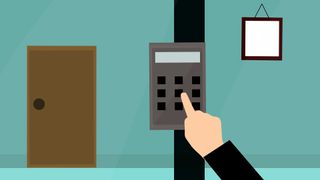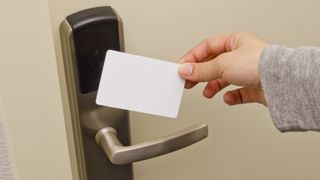How to choose and evaluate an Access Control System
Follow these tips to pick the right Access Control System for your home or business

Figuring out what access control your home or business needs can feel like an overwhelming proposition, but it does not need to be. While there are more choices than ever in access control systems, it all starts with an accurate assessment of your facility’s needs. While access control systems have traditionally been associated with larger facilities with complex access control needs, such as an airport, stadium, or healthcare, also keep in mind that smaller buildings can benefit as well, or even for a residential application. All types of businesses have security needs, and having a solid access control system can form a crucial component of the overall security plan.
- We've put together a list of the best security camera systems for your business
- These are the best secure routers on the market
- Also check out our roundup of the best security keys
An access control, at its core, has a single purpose to control access to the facility. This includes both the overall access, such as restricting visitors, and also movement within the facility. This can be a simpler system, such as controlling, and tracking access to the storeroom for a handful of employees of a retail business. At the other end, a more complicated access situation would be a sports stadium, with thousands of users, and hundreds of doors, all with tiered access and permissions for which employees can enter which areas, along with restricting thousands of visitors for each event.
Determining your needs
Therefore, the first step to choosing an access control system is to take a realistic look at your needs. This starts with a simple count of the number of openings to protect. Think about both interior, and exterior portals, that need to be secured. Pay attention to the type of locks that are already there. If the lock is electronic, it may be able to be interfaced into the access control system. On the other hand, if the lock is mechanical, it will need to be swapped for an electronic one.
Next, think about what level of security will be needed. After all, not everyone needs a Fort Knox security level that is 100% plus secured for their facility. Maybe we are only talking about a few interior doors, such as a few offices, that can be secured with a numeric keypad for a more affordable solution.
In fact, doors can be individually secured with numeric keypads, on an individual basis. This is an inexpensive approach to access control, and often referred to as a standalone system. While the cost is the selling point, be aware that this approach results in a less robust system. Compare it to a networked access control system, where each piece of the system is connected, via the network, to a central control system. This then facilitates a more comprehensive control of a facility overall. In addition, a networked access control system also will be able to track which users went through each portal, and at what time. More complicated questions can also be answered, such as what times are the busiest at the facility, or in case of a security breach, which cardholders were in the vicinity at the exact time of the incident.
Also, take stock of the users of the access control system. This can number into the thousands at a larger facility, like an airport, or just a handful of users are a residence. Also, the number of visitors matters, and how restricted they need to be, and if they are going to need temporary access. Some access control systems can provide visitor access with temporary passes, and even background check visitors against known criminal databases for a significantly higher level of security.

Providing access to employees and visitors
The access cards are yet another differentiator between access control systems. This crucial piece provides some options for users. Pay attention to the standards of the cards, as some are proprietary, while others are an open standard. Some systems offer cards that are only cards, while others can also function as ID badges for an organization. Creating these ID badge/access control cards is an added cost, but quite convenient, and allows employees to have a single card for multiple needs. While a specialized printer is required, it can be far more convenient and timely to print the cards on demand, but the other option is to outsource this activity as it is an additional burden that requires a trained staff member.
Are you a pro? Subscribe to our newsletter
Sign up to the TechRadar Pro newsletter to get all the top news, opinion, features and guidance your business needs to succeed!

While these access cards often form the cornerstone of the system, they are far from the only option. Some systems can alternatively use a smartphone app, which can be an attractive alternative. This offers convenience, along with potential cost savings as there is no physical card to create and maintain. There is also the possibility of a smartwatch as well for the access key.
Offering an even higher level of security are the biometric options. The idea here is to use an embedded physical characteristic of the user, along with the access card for the utmost in security. A common biometric option is a fingerprint reader, although alternatives such as retina scanners, or hand vein scanners offer other possibilities. In some cases, these biometric options can also provide an additional stopgap measure in a worst case scenario where a user’s access card is pilfered, the crook will still not be able to gain access to the facility.
Powering an Access Control System
Wiring the system is another item to give some thought to. Some manufacturers end up needing both electricity and a wired Ethernet connection to each access control reader. This can end up getting expensive to get two different wires to each device, particularly if the reader is directly wired, and not plugged into an outlet.
For a less expensive deployment, consider a wireless reader as the Ethernet wire can be eliminated. Still, another option is to use Power over Ethernet (PoE), which is a way to connect the card reader with a single wire. With a PoE deployment, this single wire is the Ethernet cable for the data connection, and also gets energized at a lower voltage than household current to also supply the power to the devices.
With so many different options, facilities have more choices to find a system that suits their needs- and budget. Be sure to take a frank look of your facility’s needs and budget, to choose the right access control system.
- We've also highlighted the best access control systems
Jonas P. DeMuro is a freelance reviewer covering wireless networking hardware.

